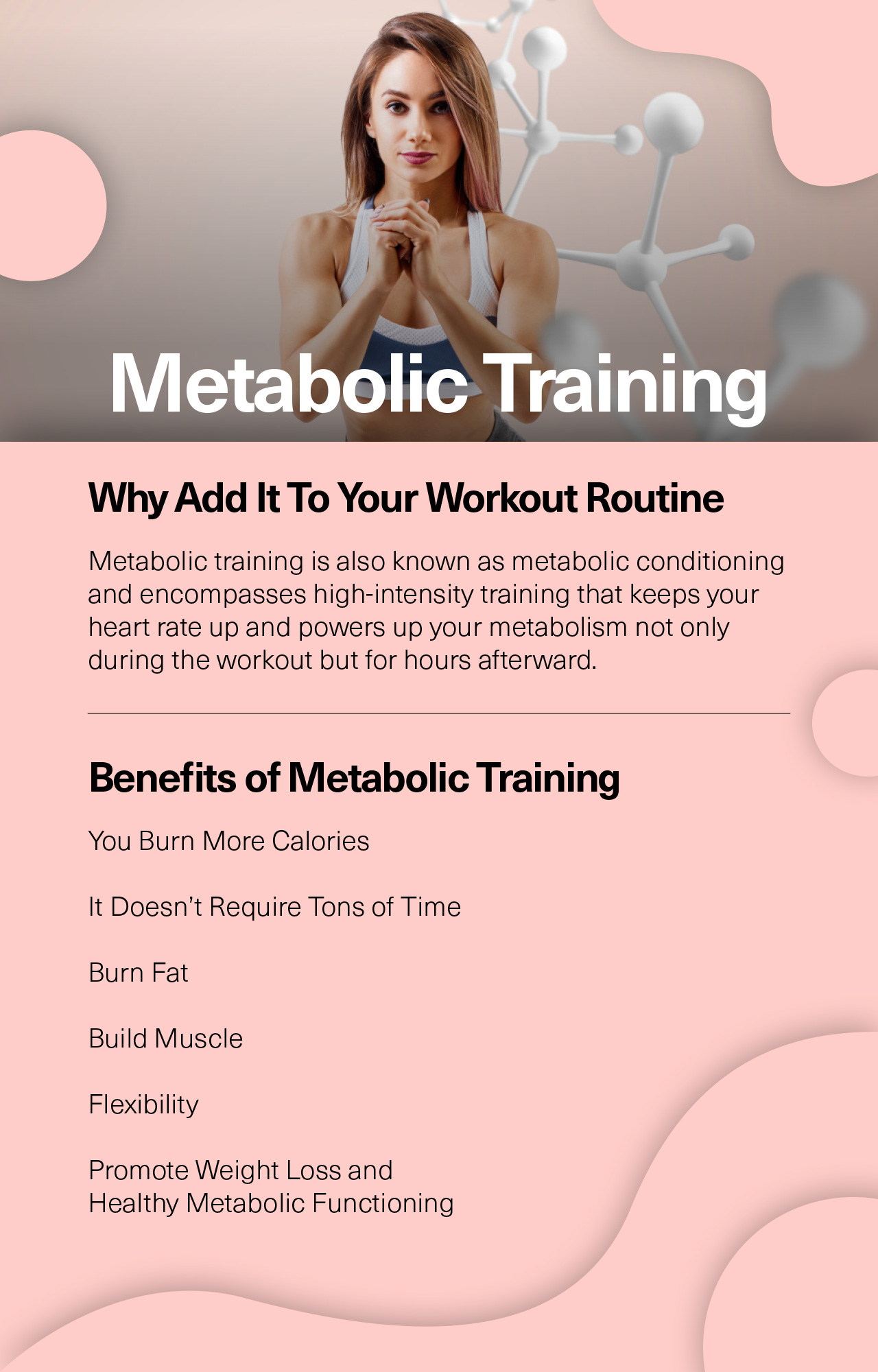Though you may have heard of high-intensity interval training (HIIT), you may not have heard of metabolic training. Metabolic training is the best kind of workout you can do, with the potential for supporting the reversal and prevention of metabolic and cardiovascular diseases. So, what is metabolic training? Keep reading to find out what metabolic training means and how to add it to your workout regimen.
What Is Metabolic Training?
First, let’s define what metabolic training is. Metabolic training is also known as metabolic conditioning and encompasses high-intensity training that keeps your heart rate up and powers up your metabolism not only during the workout but for hours afterward.
The intensity of metabolic training is the factor that distinguishes it from other exercises like a normal weight-lifting session or a 30-minute job. Metabolic training requires spurts of physical exertion at an intensity so high that it is only sustainable for a minute or so, at most. These short periods of maximum exertion are followed by a recovery period just long enough to prepare your body for another round, but short enough to keep your heart rate up.
Generally, metabolic training can be categorized as cardio-based metabolic training or metabolic resistance training, or a mix of both. Cardio-based metabolic training is an aerobic form of exercise and challenges the cardiovascular system. HIIT generally refers to cardio-based metabolic training.
Metabolic resistance training is a type of metabolic training that focuses on strength training, rather than aerobic exercise. This form of metabolic training focuses on building lots of muscle.

Benefits of Metabolic Training
Adding metabolic training to your workout regimen has many positive health impacts.
1. You Burn More Calories
Because metabolic exercises are designed to be very high intensity, your heart rate and metabolism accelerate quickly. The body burns through tons of energy in a very short period of time and continues to burn calories even after your workout is over.
2. It Doesn’t Require Tons of Time
Short on time? Don’t sweat it! You can complete a high-intensity metabolic workout in as little as 15 minutes while gaining the same results as you would with a longer, moderate-intensity workout.
3. Burn Fat
Because your body’s metabolism is sent into overdrive during a metabolic workout, your body will begin using fat reserves for energy. This, in turn, will help your body burn excess fat while building muscle. Metabolic training maximizes your body’s fat-burning capacity.
4. Build Muscle
Metabolic resistance training delivers your muscles an ultimate challenge. Paired with proper nutrition, metabolic training will help you build muscle mass while burning body fat.
5. Flexibility
You can design a metabolic workout to fit your specific goals. A metabolic workout can be an aerobic workout, strength training workout, or a combination of the two. A metabolic workout can incorporate weights, or it can rely on bodyweight exercises. The choice is yours, based on your goals and needs!
6. Promote Weight Loss and Healthy Metabolic Functioning
Metabolic training has such a dramatic effect on metabolism, increasing and sustaining a high metabolic rate that surpasses that achieved through other forms of lower-intensity exercise. As a result, metabolic training can facilitate weight loss. Paired with a nutritious diet, metabolic training has the potential to help reverse fatty liver disease, re-balance hormonal function, restore insulin sensitivity, lower blood sugar levels, and help send type 2 diabetes into remission.
How to Make Your Own Metabolic Workout Program
Making your own metabolic workout program isn’t as difficult as it sounds. Designing a metabolic conditioning program relies mainly on performing exercises in an interval pattern at high intensity.
Alternating Cardio, Strength Training, and Mixed Workouts
To get the full benefits of metabolic training, try mixing up your workout regimen with different types of exertion, including cardio, strength training, and a combination of both. Typically, exercises in a metabolic workout program will engage several muscle groups to ensure that you’re applying your energy at maximum capacity. The most important part of metabolic workouts is the intensity.
Exercising in Intervals
Performing exercises in intervals is a key part of metabolic training. Intervals of exertion and rest allow you to push your body to the limit and recover just enough to repeat it. As a rule of thumb, the period of exertion should be at least twice as long as periods of rest.
Feel free to adjust the timing of intervals to suit your needs. If you want a bigger challenge, increase the time of your exertion intervals or decrease the time of rest intervals. However, if you’re performing at maximum capacity, a minute of sustained effort should be about all you can handle.
Exercises are generally performed in sets, containing three repetitions. Just for example’s sake, let’s say one of your exercises is squats. For the first repetition, you would do squats for 45 seconds, followed by 15 seconds of rest. Repeat this exercise three times to complete a set, before moving on to your next exercise.
When moving onto your next exercise, only allow a period of time that is equivalent to your rest time. When you combine several sets of exercises with no break in between, these are called supersets.
A metabolic exercise program can contain many exercises that can be followed in a circuit pattern. Repeating a pattern of exercises is called circuit training and is a highly efficient way to complete a metabolic workout.
Examples of Metabolic Training Exercises
Here are a few examples of different types of metabolic training exercises that you can combine into a full workout. Remember, exercises don’t need to be complicated! The most important part of metabolic training is that you give each exercise 100% effort.
Walking Lunges with Weights
Walking weighted lunges challenges the quads, glutes, and shoulders. Choose the heaviest dumbbells that you can handle and carry one in each hand. Walk across the room by taking a large step with one foot, while bringing your other knee as close to the ground as possible. Complete as many lunges as you can over the course of 45 seconds, then rest for 15 seconds.
Mountain Climbers
Mountain climbers are good bodyweight exercises that also get the heart pumping. Assume pushup on the ground, with your toes on the floor and arms outstretched. Instead of performing pushups, bring your knee up to your chest, alternating legs. Perform this as fast as possible for 45 seconds, followed by 15 seconds of rest.
Sprints
Incorporating sprints into metabolic training is an excellent aerobic exercise for cardiovascular health. Try sprinting for 20 seconds followed by 10 seconds of rest. Sprints can be performed in your yard, neighborhood, or on the treadmill. Make sure your sprint is actually a sprint, and not simply a fast run. If you need to decrease the exertion interval of time to sustain a sprint, that’s ok!
Dumbbell Squats with Overhead Press
Dumbbell squats with overhead press should be performed in one fluid motion to test the entire body. Choose dumbbells that are heavy enough to be challenging, but light enough that you are able to lift them in the air. Stand with your feet shoulder-width apart, holding the dumbbells at your shoulder while lowering yourself into a squat. Then, use the power from your legs to lift up and extend your arms above your head, working out the glutes and hamstrings as well as your shoulder and arm muscles. Continue for 45 seconds followed by 15 seconds of rest.
Kettlebell Swings
Choose a kettlebell and hold onto it with both hands. Keeping your feet shoulder-width apart and your back straight, hinge at the hips while swinging the kettlebell between your legs and then outwards. You should feel your muscles working in your glutes and core. Continue for 45 seconds followed by 15 seconds of rest.
Burpees
Burpees are excellent bodyweight exercises that also get your heart rate up. Start by assuming a pushup position, with your arms outstretched and toes on the ground. Bring your feet between your arms, stand up, and jump as high as you can, before going back into a pushup position. For an extra challenge, add a pushup to each burpee. Continue this movement over the course of 60 seconds, followed by 20 seconds of rest.

Tips for Metabolic Training
Follow these five tips to get the most out of your metabolic training plan.
1. Give It Your All
Just doing exercise intervals at half capacity doesn’t qualify as metabolic conditioning. To maximize your metabolic rate, you really have to put in 100% effort while completing exercises. How do you know if you’re giving it your all? You should feel your muscles burning by the end of a repetition, followed by afterburn. The afterburn upon completing a repetition is a result of excess post-exercise oxygen consumption, signaling that you’re pushing your body hard. Towards the end of a workout, the body should be fatigued and nearly unable to keep going.
2. Engage the Entire Body
In general, a metabolic workout is dynamic and challenges the entire body. You can design a full-body metabolic workout to hit all muscle groups, or you can do a metabolic workout focusing more on the upper body or lower body.
3. Always Warm-Up
Nothing spells out “injury” more than throwing a stiff body into a maximum-intensity lunge and overhead press with weights. Always do at least five minutes of warm-ups before diving into high-intensity exercises.
Here are a few good warm-Up options:
- Jumping while trying to get your knees as high as possible
- Running in place
- Toe touches
- Core twists
4. Start Slow
If you’re new to metabolic training or working out, don’t try to do a full hour workout with intervals of 60 seconds exertion and 15 seconds of rest. Instead, first complete a 15-minute workout with intervals of exertion set to 45 seconds, with 15 seconds of rest. Stick to bodyweight exercises and focus on putting in full effort. Over time, you can build up your strength and increase the time on periods of exertion.
5. Attend a Workout Class
If you’re new to working out, attending a workout class can be helpful for learning new exercises that you can then implement on your own. CrossFit training and HIIT classes can help you get a feel of high-intensity exercise. However, any workout class will help you get familiar with different weights, equipment, and moves, and give you ideas for creating your own workout.
A certified personal trainer is also a helpful resource for learning new exercises and designing metabolic workout plans.
Proper Nutrition for Metabolic Training
Because of the high intensity that a metabolic training program entails, it is absolutely crucial to ensure that nutrition supports recovery. This means properly fueling your workouts and properly refueling after a workout. The pillars of proper nutrition for metabolic training involve carbs, essential amino acids, a variety of whole foods, and proper hydration.
Carbs Are Friends
When you’re going for maximum-intensity workouts, you need fuel. Carbs are broken down into sugar molecules that the body uses for immediate energy. Without carbs, your maximum energy output will be much lower than with carbs. Eating your carbs a couple hours before a workout will give your body sufficient time to break down carbohydrate molecules into useable energy. Just make sure that you’re choosing the right kinds of carbs as fuel.
Complex carbohydrates found in fruits, vegetables, and whole grains are much healthier than refined carbohydrates found in processed foods like cookies, granola bars, and boxed cereals. Refined carbohydrates spike your blood sugar and lead to an energy crash. In the long run, refined carbs contribute to insulin resistance, type 2 diabetes, and fatty liver disease. For more sustainable energy, choose carbohydrates from foods like sweet potatoes, whole-grain bread, brown rice, quinoa, oats, squash, pumpkin, berries, and bananas.
Essential Amino Acids for Muscle Growth
Essential amino acids are required for muscle synthesis. Though most amino acids can be synthesized by the body, the essential amino acids must be obtained through dietary sources. When you’re engaging in intense workouts that incorporate strength training, your muscle fibers are tearing. When recovering from an intense session, your cells are hard at work repairing and rebuilding muscle tissue. However, the body is unable to adequately repair and rebuild muscle without optimal ratios of all nine essential amino acids, including histidine, threonine, methionine, lysine, leucine, isoleucine, valine, phenylalanine, and tryptophan.
Muscle tissue also plays a vital role in keeping your metabolism high. The amount of lean muscle mass on your body actually determines your resting metabolic rate. Therefore, it’s important to feed your growing muscles with all the essential amino acids they need. All animal proteins provide optimal ratios of amino acids. When choosing animal proteins, stick to chicken, fish, and low-fat dairy like Greek yogurt and whey protein. With the exception of soy protein, most plant proteins don’t provide all essential amino acids and must be combined throughout the course of the day to meet amino acid requirements. Combining a variety of beans, nuts, seeds, and whole grains throughout the day can help provide all essential amino acids that your muscles require.
Essential amino acid supplements can eliminate the guesswork involved when trying to determine whether your body is getting ideal amounts of the amino acids it needs.
Whole Foods Packed with Vitamins and Minerals
The bulk of your diet, to get the best results from metabolic training, should come primarily from whole foods including fruits, veggies, whole grains, nuts, seeds, beans, fish, low-fat dairy, and lean meats. Plant foods provide a wealth of antioxidant agents like polyphenols, carotenoids, and vitamin C that promote a healthy immune response and expedite cellular repair.
Nuts, seeds, and fatty fish provide healthy fats like omega-3 fatty acids that help lower systemic inflammation and fuel the body.
Smaller portions of low-fat dairy and lean meats can provide high-quality protein that contains all essential amino acids.
It’s also important to make sure you get enough of all macronutrients and calories. Counting macros can be a helpful strategy for making sure you’re getting the nutrients you need.
Hydration
When you’re working out using an intense metabolic training program, hydration is crucial. Intense exertion without proper hydration can lead to dizziness and low blood pressure. Aim to drink at least 2 liters of water each day, especially on the days that you work out. If you need electrolytes, low-sugar electrolyte tablets can help replenish potassium and sodium reserves.
Things to Keep in Mind
If you have a heart condition or have to moderate your exercise due to a physical condition, make sure to check in with your doctor before taking up metabolic training. It’s important to first be cleared by a health professional before engaging in very high-intensity exercise.
Conclusion
Metabolic conditioning is the perfect exercise regimen if you want to maximize your time for the best results. Metabolic workouts rely on high-intensity exercises performed in intervals to get your heart rate up, muscles burning, and metabolism fired up. Combined with a diet rich in healthy fats, antioxidants, and essential amino acids, metabolic training is key for improving metabolic and cardiovascular health.























